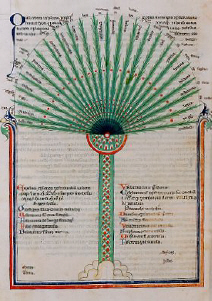Excertos de GEORGE GEMISTOS PLETHON: THE LAST OF THE HELLENES
There is something of a legend among historians of the late Byzantine Empire and the early Italian Renaissance about George Gemistos, who called himself Plethon. The legend has still to be completely explored. There have been many monographs about different aspects of his life and works, and most of what he wrote has been published, though in scattered and often inaccessible editions. There has been no previous account in any language of his life and writings as a whole. He remains an interesting and mysterious figure in the last century of Byzantium. Whether he was an important figure, and if so in what way, has still to be explained.
Exploring the legend is a difficult task, simply because it is a legend. It rests chiefly, but not exclusively, on the impact he made by his presence in Florence in 1439, the lectures he gave there ‘On the Differences of Aristotle from Plato’ (or, more precisely, ‘with regard to Plato’), and the long essay in which he summarized them, usually known as De Differentiis. It is a commonplace among scholars that the Italians who formed his audience were greatly impressed by his personality and his arguments. Sir Steven Runciman has written that ‘in Italy, where the learned world had come to realize what a store of knowledge was to be found in Byzantium, the intellectuals longed to see this illustrious philosopher’. François Masai wrote that ‘Plethon est entré en relation, non pas seulement avec des personnages secondaires,… mais avec les coryphées de l’humanisme italien …’. Many other scholars have written to similar effect. They echo statements contained in the two surviving funeral orations on Gemistos.
No doubt they are right, but the evidence of his influence is surprisingly slight. The number of Gemistos’ identifiable acquaintances in Italy is small. Only one — Ciriaco Pizzicolli (in Greek Kyriakos, and in English Cyriac of Ancona), who was a keen antiquarian but not a philosopher — can be said with certainty to have known Gemistos before his visit to Italy. Only two — Cosimo de’ Medici and Grigorio Tifernate — are known with certainty to have heard Gemistos’ lectures at Florence. Cosimo de’ Medici was of course the pre-eminent name: if he went to hear Gemistos, then many of his circle would have gone also.
Further than this it is hard to go. Five other Italians are known by name who encountered Gemistos: Ugo Benzi at Ferrara; Francesco Filelfo at Bologna; Lionardo Bruni, Paolo Toscanelli, and Pietro Vitali (called ‘Peter of Calabria’) at Florence; but only the last three could have heard his lectures, and it is no more than a strong presumption that they did so. As for the text of De Differentiis, only one manuscript (the autograph) is known to have been available in Italy during his lifetime, and that was in the hands not of any of his Italian friends (though it was for them that he wrote it) but of his former pupil, Cardinal Bessarion. So far as the names of individuals go, the rest is all conjecture, though much of the conjecture is no doubt well based.
Gemistos’ place in the intersecting worlds of Greek and Latin humanism, and thus in the western Renaissance, remains to be assessed. I started work on his life and writings with the presumption that he was, as he has often been called, the one significant and original philosopher of the late Byzantine Empire. Of this I have become increasingly sceptical. Certainly he can be, and perhaps has been, overrated as a philosopher. But I have come to the conclusion that he was indeed an influential figure in the cultural history of Europe for reasons other than those usually supposed.
It is probably true that he was the first competent interpreter of both Platonism and Aristotelianism to address Latin audiences in Greek for a thousand years. That fact alone should have assured him of an interested audience. When he did so, the process of translating Plato into Latin was still in its early stages, though the translation of Aristotle was almost complete. It was not until 1423 that the complete corpus of Plato’s surviving works was available in the West even in the original Greek. The philosophical study of Plato, as distinct from the literary task of translation, had scarcely begun. In effect, it began with Gemistos’ arrival.
But the outcome was not what he intended. He intended to establish Plato in the place of Aristotle as the foundation of metaphysical speculation, and hence of physical science as well. Instead he succeeded unintentionally in fascinating the West with Platonic imagery and poetry, which affected writers and artists more than philosophers and scientists. Philosophers continued for generations to adhere to Aristotelianism as interpreted in the scholastic tradition.
Even when they discarded Aristotle, it was not to put Plato in his place. But poets, painters, sculptors, and creators of works of imagination in general took Plato to their hearts. This would have disappointed Gemistos, who had little interest in the arts. But it was, willy-nilly, his real legacy to the West, which justifies Masai’s assertion that l’action de Plethon sur la Renaissance est certaine.
